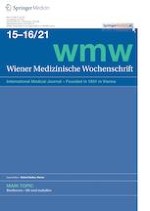Anzeige
30.04.2021 | main topic
Beethoven’s death as the starting point for Rokitansky’s family ties to the art world “We were there when they buried him and when he died we wept.”
Erschienen in: Wiener Medizinische Wochenschrift | Ausgabe 15-16/2021
Einloggen, um Zugang zu erhaltenSummary
Carl Freiherr von Rokitansky (1804–1878) is well known as a pathologist in medical history literature. This article provides a detailed account of his family and artistic background and also analyses his demands for freedom in both science and the arts, and how they influenced subsequent generations of the Rokitansky family. The Rokitansky, Teltscher, Hüttenbrenner and Lablache families were either directly present at Ludwig van Beethoven’s (1770–1827) deathbed or played a role in his funeral ceremony; within a few years they had also built family ties. The descendants of these families also went on to support artists such as Gustav Mahler (1860–1911), Thomas Bernhard (1931–1989) and Peter Turrini (born 1944). Rokitansky’s wife was the internationally recognized concert singer Marie Weis (1806–1888), who had been trained by Antonio Salieri (1750–1825). Through her the family developed cordial relationships with Salieri, Franz Schubert (1797–1828) and Franz Grillparzer (1791–1872), which in turn resulted in indirect links to Ludwig van Beethoven. Grillparzer later supported liberal causes together with Rokitansky. Beethoven’s death marked the beginning of the Rokitansky and Weis family ties to the art world, whose descendants in turn influenced the cultural landscape of Austria according to Rokitansky’s ideal of freedom in science and art.
